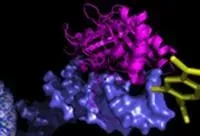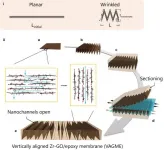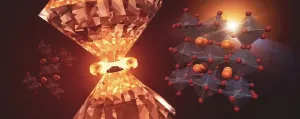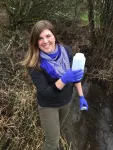(Press-News.org) Researchers at Vanderbilt University Medical Center and colleagues have identified genetic factors that increase the risk for developing pneumonia and its severe, life-threatening consequences.
Their findings, published recently in the American Journal of Human Genetics, may aid efforts to identify patients with COVID-19 at greatest risk for pneumonia, and enable earlier interventions to prevent severe illness and death.
Despite the increasing availability of COVID-19 vaccines, it will take months to inoculate enough people to bring the pandemic under control, experts predict. In the meantime, thousands of Americans are hospitalized and die from COVID-19 each day.
"This study is so important because we performed analyses separately in participants of Caucasian ancestry as well as African ancestry to identify genetic risk factors contributing to pneumonia susceptibility and severity," said Jennifer "Piper" Below, PhD, associate professor of Medicine and the paper's corresponding author.
"Combined with systemic racism and socioeconomic factors that have been reported by others, these genetic risk differences may contribute to some of the disparities we observe in COVID-19 outcomes," Below said.
The researchers conducted genome-wide association studies (GWAS) of more than 85,000 patients whose genetic information is stored in VUMC's BioVU biobank and which has been linked to "de-identified" electronic health records stripped of personal identifying information. GWAS can identify associations between genetic variations and disease.
With colleagues from the University of North Carolina at Chapel Hill, the University of Texas MD Anderson Cancer Center in Houston, and the Icahn School of Medicine at Mount Sinai in New York, the VUMC researchers identified nearly 9,000 cases of pneumonia in patients of European ancestry, and 1,710 cases in patients of African ancestry.
The strongest pneumonia association in patients of European ancestry was the gene that causes cystic fibrosis (CF). This disease produces abnormally thick mucus leading to chronic infections and progressive respiratory failure.
In patients of African ancestry, the strongest pneumonia association was the mutation that causes sickle cell disease (SCD), a red blood cell disorder that increases the risk for pneumonia, influenza and acute respiratory infections.
Children with CF and SCD are at particular risk for severe disease if they contract COVID-19.
The researchers found that "carriers" who are unaffected by CF yet carry a copy of the CF gene had a heightened susceptibility to pneumonia, and those who are unaffected by SCD yet carry a copy of the SCD mutation were at increased risk for severe pneumonia.
Further studies will be needed to determine whether these carriers also bear "a silent, heightened risk for poor outcomes from COVID-19," the researchers said.
To identify other genetic variations that increase pneumonia risk, they removed patients with CF and SCD from their analysis, repeated the GWAS, and used another technique called PrediXcan, which correlates gene expression data with traits and diseases in the electronic health record.
This time they found a pneumonia-associated variation in a gene called R3HCC1L in patients of European ancestry, and one near a gene called UQCRFS1 in patients of African ancestry. The molecular function of R3HCC1L is unclear, but deletion of the UQCRFS1 in mice disrupts part of their infection-fighting immune response.
"Although our understanding about the genetic mechanism of pneumonia is still limited, this study identified the novel candidate genes, R3HCC1L and UQCRFS1, and offered an insight for further host genetic studies of COVID-19," said the paper's first author, Hung-Hsin Chen, PhD, MS, a postdoctoral fellow in Below's lab.
"Our findings may be applied to identify the individuals with high risk of severe pneumonia and develop a precise treatment for them," Chen said.
INFORMATION:
Other VUMC coauthors were Douglas Shaw, Lauren Petty, Hannah Polikowsky, Xue Zhong, PhD, MS, Megan Shuey, Nancy Cox, PhD, Julie Bastarache, MD, and Lisa Bastarache, MS.
The study was supported in part by National Institutes of Health grants TR002243, GM133169 and GM080178.
A new study from researchers at MIT uncovers the kinds of infrastructure improvements that would make the biggest difference in increasing the number of electric cars on the road, a key step toward reducing greenhouse gas emissions from transportation.
The researchers found that installing charging stations on residential streets, rather than just in central locations such as shopping malls, could have an outsized benefit. They also found that adding on high-speed charging stations along highways and making supplementary vehicles more easily available to people who need to travel beyond the single-charge range of their electric vehicles could greatly increase the vehicle electrification potential.
The findings are reported today in the journal Nature Energy, in a paper by MIT associate ...
DAVIS, Calif., January 21, 2020 - A new peer-reviewed study reveals that the vast majority of U.S. infants may be suffering from a substantial deficiency in an important bacterium key to breast milk utilization and immune system development, as well as protection against gut pathogens linked to common newborn conditions such as colic and diaper rash.
According to the study published today in END ...
Sex-specific chromosomes are a dangerous place to be, if you're a gene. Because these chromosomes -- Y chromosomes, in humans -- do not have a matching chromosome with which to exchange genetic information, they are prone to losing non-essential genes left and right in a process called genetic decay.
Now, a new study from research scientist Daniel Winston Bellott in the lab of Whitehead Institute Member David Page broadens our understanding of what makes a gene able to survive on a sex-specific chromosome by looking at one especially slithery branch of the evolutionary tree: snakes.
Comparing surviving genes on snake ...
PHILADELPHIA -- (Jan. 21, 2021) -- Researchers at The Wistar Institute have discovered a new enzymatic function of the Epstein-Barr Virus (EBV) protein EBNA1, a critical factor in EBV's ability to transform human cells and cause cancer. Published in Cell, this study provides new indications for inhibiting EBNA1 function, opening up fresh avenues for development of therapies to treat EBV-associated cancers.
EBV establishes life-long, latent infection in B lymphocytes, which can contribute to development of different cancer types, including Burkitt's lymphoma, nasopharyngeal carcinoma (NPC) and Hodgkin's lymphoma.
The Epstein-Barr Nuclear Antigen 1 (EBNA1) serves as an attractive therapeutic ...
Two out of five individuals delayed or missed medical care in the early phase of the pandemic--from March through mid-July 2020--according to a new survey from researchers at the Johns Hopkins Bloomberg School of Public Health.
The survey of 1,337 U.S. adults found that 544, or 41 percent, delayed or missed medical care during the survey period. Among the 1,055 individuals who reported needing medical care, 29 percent (307 respondents), indicated fear of transmission of COVID-19 as the main reason. Seven percent (75 respondents) reported financial concerns as the main reason for delaying ...
Researchers from the University Hospitals in Zurich and Basel, ETH Zurich, University of Zurich and the pharmaceutical company Roche have set out to improve cancer diagnostics by developing a platform of state-of-the-art molecular biology methods. The "Tumor Profiler" project aims to derive the comprehensive molecular profile of tumours in cancer patients, which has the potential to predict the efficacy of a host of new cancer medications. It will therefore make it possible to offer treating physicians personalised and improved therapy recommendations.
Three years ago, the researchers began a large-scale clinical study involving ...
PROVIDENCE, R.I. [Brown University] -- When sheets of two-dimensional nanomaterials like graphene are stacked on top of each other, tiny gaps form between the sheets that have a wide variety of potential uses. In research published in the journal Nature Communications, a team of Brown University researchers has found a way to orient those gaps, called nanochannels, in a way that makes them more useful for filtering water and other liquids of nanoscale contaminants.
"In the last decade, a whole field has sprung up to study these spaces that form between 2-D nanomaterials," said Robert Hurt, a professor in Brown's School of Engineering and coauthor of the ...
TROY, N.Y. -- Warnings about misinformation are now regularly posted on Twitter, Facebook, and other social media platforms, but not all of these cautions are created equal. New research from Rensselaer Polytechnic Institute shows that artificial intelligence can help form accurate news assessments -- but only when a news story is first emerging.
These findings were recently published in Computers in Human Behavior Reports by an interdisciplinary team of Rensselaer researchers. They found that AI-driven interventions are generally ineffective when used to flag issues with stories on frequently covered ...
Among the materials known as perovskites, one of the most exciting is a material that can convert sunlight to electricity as efficiently as today's commercial silicon solar cells and has the potential for being much cheaper and easier to manufacture.
There's just one problem: Of the four possible atomic configurations, or phases, this material can take, three are efficient but unstable at room temperature and in ordinary environments, and they quickly revert to the fourth phase, which is completely useless for solar applications.
Now scientists at Stanford ...
Delivering a minor electric shock into a stream to reveal any fish lurking nearby may be the gold standard for detecting fish populations, but it's not much fun for the trout.
Scientists at Oregon State University have found that sampling stream water for evidence of the presence of various species using environmental DNA, known as eDNA, can be more accurate than electrofishing, without disrupting the fish.
"It's revolutionizing the way we do fish ecology work," said Brooke Penaluna, a research fish biologist with the U.S. Department of Agriculture Forest Service who also has an appointment in OSU's Department ...






